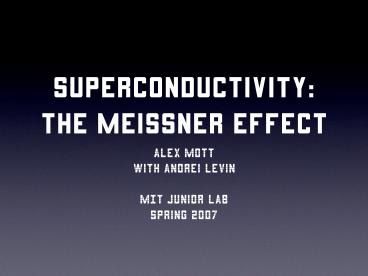Superconductivity: The Meissner Effect - PowerPoint PPT Presentation
1 / 21
Title:
Superconductivity: The Meissner Effect
Description:
Cooper Pairs form between electrons: Near the Fermi Surface. On opposite ... Cooper Pair moves as one unit. Resists kicks' and thus experiences no resistance ... – PowerPoint PPT presentation
Number of Views:4661
Avg rating:5.0/5.0
Title: Superconductivity: The Meissner Effect
1
Superconductivity The Meissner Effect
- Alex Mott
- with Andrei Levin
- MIT Junior Lab
- Spring 2007
2
Outline
- Motivation
- BCS theory
- The London Equation
- Perfect conductor versus superconductor
- Experimental Setup
- Demonstration of Meissner Effect
- Measuring Tc
- Error Analysis
- Conclusions
3
Motivation
- 0 electrical resistance
- Can store current indefinitely
- Can create large B-fields
- CMS magnets
- MagLev train
cms.cern.ch
superconductors.org
4
BCS Theory
- Electrons distort lattice
- Bind into Cooper Pairs through lattice distortion
- Cooper pair behaves as a boson
- Stay together as long as thermal vibrations are
small
5
BCS Conductivity
- Cooper Pairs form between electrons
- Near the Fermi Surface
- On opposite sides of Fermi Sphere
- At low energy
- Cooper Pair moves as one unit
- Resists kicks and thus experiences no
resistance - At higher energy
- Cooper Pair is broken
- End of superconductivity
6
The London Equation
- Initially guessed
- Can be derived from BCS
- The London Equation
- Combining with
- We conclude that
- Which has solution
7
Implications of the London Equation
- Valid only for superconductors
- B 0 deep inside
- SC will abruptly expel any magnetic field when
cooled past Tc
8
Perfect Conductors
- Perfect conductors also have 0 resistance
- Not governed by London Equation
- Can show
- The solution gives
- Magnetic fields frozen in
9
Perfect Conductors Versus Superconductors
- Both expel changing magnetic fields
- SC expels static magnetic fields
- SC will not form in a strong B-field
10
Experimental Setup
- SC sample surrounded by 2 coils
- Apply current to outer coil
- Measure inductance on inner
- Inductance proportional to cross-sectional area
- SC effectively reduces area
- Measure current above and below Tc
11
Experimental Setup
12
Sample Data
Niobium
13.2K
7.3K
13
Demonstration of Meissner Effect
Decreasing Temperature
Increasing Temperature
14
SC Transition Niobium
15
SC Transition Vanadium
16
SC Transition Lead
17
Extracting Tc
- Find level of sub-Tc plateau
- Record highest T
18
Sources of Error
- Error bars
- Granularity in scope
- Error reading temp
- Something is wrong
- Drifting reduced by averaging
- Temp sensor may be systematically warmer than
sample
19
Applying a B-Field
Niobium
20
Systematics
- Temperature Sensor is systematically warmer than
the sample - Scale using Niobium (Tc 9.3 K)
For Niobium
21
Conclusions
- Shown Meissner Effect
- Seen Tc transition
- Determined Tc for Nb, Pb, Va
- Systematics Correction
- Redo experiment with better temperature
measurements































